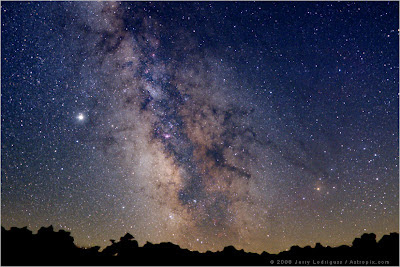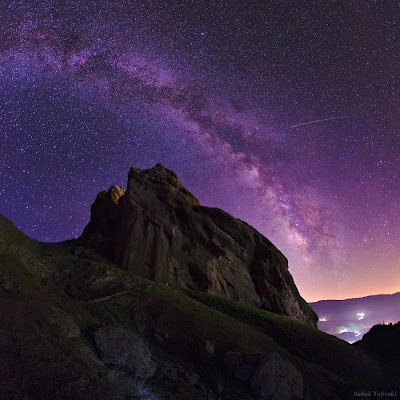A starry sky is always a very relaxing and touching view, and often, if we spend some time to contemplate it, when our eyes are well adapted to darkness, we could spot some steady "white clouds" between the stars.
Fortunately that is no premonition of rain, because those clouds are well beyond the Earth's atmosphere. That is the Milky Way, no less than the very galaxy we live in!
[This is a post which is part of the series: 5 unmissable celestial events]
Physical background:
Why do we see the galaxy we are in, on our skies?
The answer lies in the structure of our galaxy and the position in which we are.
 |
| Reconstruction of the Milky way. |
Our position in the galaxy is about 26000 light years from the center, that is quite reassuring, but also allow us to have some fantastic views of the galactic center with the galactic arms.
What do we see of the Milky Way is also a problem that involves the knowledge of the motion of the solar system through the galaxy.
The Sun is supposed to orbit around the galactic center with a period of revolution of 225-250 million years - then this does not affect the milky way position in few (even thousands) years. The inclination of the ecliptic plane (Earth's orbital plane around the sun) with respect of the galactic plane is supposed to be around 60°, with the Northern hemisphere facing relatively away from the galactic center. This is why the center of the Milky Way (that corresponds to Sagittarius alpha) is best seen from the Southern hemisphere, since in the Northern hemisphere it will be near the horizon on the best times of the year. The other parameter that affects the Milky Way visibility is of course the sun. It is in conjunction with Sagittarius in spring, but this won't stop you to see the outer arm of the galaxy: the Perseus Arm.
 |
| This is what most probably the Milky way would look like with naked eye and excellent visibility |
Unfortunately there is another problem that increases the difficulty to spot the Milky Way.
Our eyes can only catch the bright light from stars; "gassy" objects like the stunningly colored nebulae, galaxies and our Milky Way as well, require a more sensitive equipment since the light that they emit is dim enough to seem black as pitch to human eyes. On the left it is an image of how the Milky Way may appear to human eyes in excellent conditions.
That is still a quite stunning result: the dark patches are evident in the photo and they correspond to the dense gases that shield the light from the brightest regions of the galaxy. On the other side, the details in the image are quite poor. What if you could improve your brightness sensitivity? What if you could sum up the dim light received from the galaxy? Grab a camera, increase the exposure time and get ready to obtain this:
Result:
... It's worth it, isn't it?
Locations:
In order to have good sights of the Milky Way the first requirement is a very dark sky. The city-light is the first enemy: you need to get away from cities as far as possible; but this can't do anything but good (in every sense you can think of). Moonlight is also to avoid at all costs.
Do not bring with you any telescope (unless you want to have some other observations). You don't need any to see the Milky Way, since it is a diffuse object and spreads over the sky.
Choose a suitable time (night obviously) and season. As explained before, summer and winter are the best choices, even better in the Southern hemisphere if you want to spot the galactic center.
Interesting Links:
Time Lapse video of the rising Milky Way's Galactic Center
Time Lapse video of the Milky Way in the Southern Hemisphere
Stellarium: Great program to emulate night sky



No comments:
Post a Comment